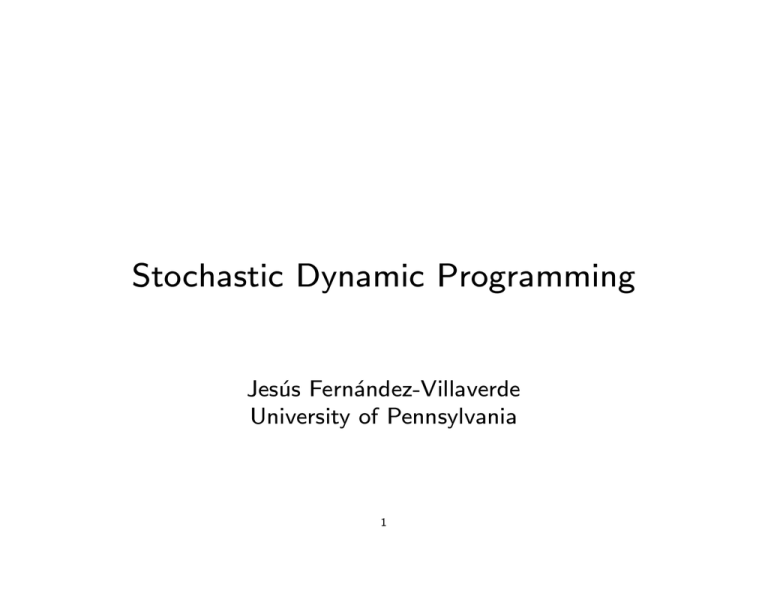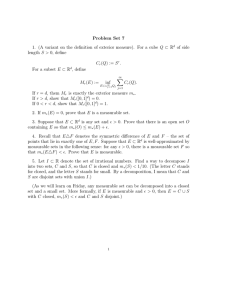Stochastic Dynamic Programming Jesus Fernandez-Villaverde University of Pennsylvania 1
advertisement

Stochastic Dynamic Programming Jesus Fernandez-Villaverde University of Pennsylvania 1 Introducing Uncertainty in Dynamic Programming Stochastic dynamic programming presents a very to handle multitude of problems in economics. exible framework We generalize the results of deterministic dynamic programming. Problem: taking care of measurability. 2 References Read chapter 9 of SLP!!!!!!!!!!!!!! Problem of SLP: based on Borel sets. Raises issues of measurability. See page 253 and 254 of SLP. Bertsekas and Shreve (Stochastic Optimal Control, 1978) redo much of the theory with universal measurability Read chapter 10 of SLP: it is full of economic applications. 3 Environment (X; X ): universally measurable space for the endogenous state. (Z; Z ): universally measurable space for the exogenous state. (S; S ): (X; X ) (Z; Z ) : Q: stationary transition function for (Z; Z ). :X Z ! X : correspondence constraint. A = f(x; y; z ) 2 X X Z:y2 (x; z )g: graph of . F : A ! R: one-period return function. : discount factor. 4 Plans t : Z t ! X for t = 1; 2; :::: sequence of measurable functions. = ( 0 2 X; t): plan. Interpretation of a plan: contingent decision rules. A plan 1. 2. is feasible from s0 2 S if: 0 2 (s0 ) : t 1 ; z for z t 2 Z t, t = 1; 2; ::: t2 t t 1 z (s0): set of all feasible plans from s0 2 S: If does not depend on t but only on z t, we call the plan stationary or Markov. 5 Some Preliminary Results I Assumption 1: 1. is non-empty valued. 2. A is (X Z) X measurable. 3. 9 a measurable selection h : S ! X s.t. h (s) 2 Lemma 1: under previous assumption, Lemma 2: A = (X Corollary 1: F X Z ) is a (s0) is nonempty for 8s0 2 S . algebra. t 1 ; t t z ; zt t 1 z 6 (s) for 8s 2 S . is Z t measurable. Some Preliminary Results II Given Q on (Z; Z ) and s0 2 S , t (z ; 0 ) : Z t ! [0; 1] , t = 1; 2; ::: Assumption 2: F : A ! R is A measurable and either (a) or (b) holds: a. F 0 or F 0: b. For each (x0; z0) = s0 2 S and each plan F t 1 ; t t z ; zt t 1 z is t (z0; ) 2 (s0), integrable, t = 1; 2; ::: and the limit: F (x0; 0; z0)+ lim t!1 1 Z X t t=1 Z tF t 1 ; t t z ; zt t 1 z exists (though it may be plus or minus in nity). 7 t (z ; 0 ) Sequential Problem De ne un ( ; s0) : (s0) ! R; n = 0; 1; ::: by: u 0 ( ; s 0 ) = F ( x0 ; 0 ; z 0 ) u n ( ; s 0 ) = F ( x0 ; 0 ; z 0 ) + De ne u ( ; s0) : n Z X t t=1 Z t t 1 ; t z ; zt t 1 z tF (s0) ! R1 by u ( ; s0) = lim un ( ; s0) n!1 De ne v : S ! R1 by v (s) = sup u ( ; s0) 2 (s) 8 t z ; dz t 0 Recursive Problem Functional equation: v (s) = v (x; z ) = sup F (x; y; z ) + y2 (x;z) Z v y; z 0 Q z; dz 0 Associate with the functional equation, we have a policy correspondence: G (x; z ) = y 2 (x; z ) : v (x; z ) = F (x; y; z ) + Z v y; z 0 Q z; dz 0 If G is nonempty and if there is a sequence of measurable selections g1; ::: from G, we have the plan generated by G from s0: t t z 0 = g0 h(s0) i t 1 t = gt t 1 z ; z , 8z t 2 Z t, t = 1; 2; ::: 9 Transversality Condition In general, dynamic programming problems require two boundary conditions: an initial condition and a nal condition. Transversality condition plays the role of the second condition. To ensure the equivalence of the sequential and recursive problem, we also need then a transversality condition: lim t!1 t Z v t 1 ; zt t 1 z t z ; dz t 0 10 = 0; 8 2 (s0 ) , s0 2 S Equivalence of Sequential and Recursive Problem Under our previous assumptions: 1. v = v 2. Any plan generated by G obtains the supremum in v (s) = sup 2 (s) u ( ; s0) Under our previous assumptions and an additional boundness condition, a plan is optimal only if it is generated a.e. by G: Our results are equivalent to theorems 4.2-4.5 in SLP for the deterministic case. 11 Bounded Returns As in the deterministic case, we want to show further results. Assumptions: 1. F is bounded and continuous. 2. < 1: 3. X is a compact set in Rl and X is a universally measurable 4. Z is a compact set in Rk and Z is a universally measurable algebra. algebra. 5. Q has the Feller property. Intuition: integration will preserve properties of the return function. 12 Results I . that: Under these assumptions, we can prove 1. The Bellman operator: (T f ) (x; z ) = sup F (x; y; z ) + y2 (x;z) Z v y; z 0 Q z; dz 0 has a unique xed point. 2. Contractivity: kT nv0 vk n kv 0 vk, n = 1; 2; ::: 3. The policy correspondence G (x; z ) = y 2 (x; z ) : v (x; z ) = F (x; y; z ) + is non-empty, compact-valued, and u.h.c. Z v y; z 0 Q z; dz 0 4. The value function will inherit increasing properties from F and Q. 13 Concavity Assumption concavity 1: For each z 2 Z , F ( ; ; z ) : Az ! R satis es: F (x; y ) + (1 ) x0 ; y 0 ; z F (x; y; z ) + (1 ) F x0 ; y 0 ; z 2 (0; 1) , 8 (x; y ) ; x0; y 0 2 Az 8 and the inequality is strict if x 6= x0. Assumption concavity 2: For 8z 2 Z and 8x; x0 2 X , y 2 y 0 2 x0 ; z y + (1 ) y0 2 x + (1 14 (x; z ) and ) x0; z ; 8 2 (0; 1) Results II 1. Under previous assumptions, v ( ; z ) : X ! R is strictly concave and G ( ; z ) : X ! X is a continuous, single-valued function. 2. Let vn = T vn 1 and gn (x; z ) = arg max y2 (x;z) F (x; y; z ) + Z v y; z 0 Q z; dz 0 for n = 1; 2; ::: Then, gn ! g uniformly. 3. If x0 2 int (X ) and g (x0; z0) 2 int ( (x0; z0)), v ( ; z0) is continuously di erentiable in x at x0 with derivatives given by: vi (x0; z0) = Fi [x0; g (x0; z0) ; z0] ; i = 1; :::; l 15 Unbounded Returns What if returns, like in most applications of interest in economics, are unbounded? This was already an issue in the deterministic set-up. We can get most of the substance of previous results if F is constant returns to scale. In the case of CRRA utility functions, we would need to do some ad-hoc work. 16 Policy Functions and Transition Functions I Let us imagine that the decision maker follows g (x; z ) given an initial condition s0: The policy function generates a sequence fstg : What do we know about fstg? Read chapters 11-14 of SLP. 17 Policy Functions and Transition Functions II Let (X; X ), (Z; Z ) ; and (S; S ): (X; X ) (Z; Z ) be universally measurable spaces; let Q be a transition function on (Z; Z ) ; and let g : S ! X be a measurable function. Then: P [(x; z ) ; A B] = ( Q (z; B ) if g (x; z ) 2 A 0 otherwise for 8x 2 X; z 2 Z; A 2 X ; and B 2 Z , de nes a transition function on (S; S ). If g is continuous, then P has the Feller property. Characterizing long run behavior of the model. 18






